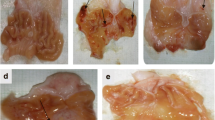Abstract.
Objective and Design: The aim of the present study was to examine the effects of cinitapride, a novel prokinetic benzamide-stimulating gastrointestinal motility agent, on gastric secretion and ulceration in rats and elucidate some possible vascular and anti-oxidant mechanisms of such protection.¶Material: Male Wistar rats.¶Treatment: Cinitapride (CNT, Lab. Almirall, S.A.) (0.25, 0.5, and 1 mg/kg) and 5-hydroxytryptamine (5-HT, Sigma Chemical Co., St. Louis, MO, USA) (10 mg/kg), administered intraperitoneally (i.p.).¶Methods: Gastric ulceration was induced by instillation of 1 mL/100 g animal of 50% (v/v) ethanol in distilled water and by pylorus-ligated rat model. Gastric microvascular changes, and the activity of myeloperoxidase (as a marker of neutrophil infiltration) and glutathione peroxidase (an important enzyme in scavenging of lipid peroxides) were determined. The results were compared with those of 5-HT. The data were evaluated using Student’s t-test for paired data and the non-parametric Mann-Whitney U-test.¶Results: In 4 h pyloric-ligated animals, i.p. CNT did not significantly reduce the incidence of gastric mucosal damage, and no significant differences were found in the values of total volume and acidity. However, CNT caused a marked and dose-dependent reduction of haemorrhagic lesions induced by 50% v/v ethanol. These protective effects were specifically related to a reduction of neutrophil infiltration. CNT at the dose of 1 mg/kg raised the decreased glutathione peroxidase activity to the control level. In contrast, pretreatment with 5-HT worsened the ethanol-induced erosions, but did not significantly induce any gastric microvascular changes. However, the myeloperoxidase activity rose markedly and the glutathione peroxidase levels decreased significantly in the mucosa injured by 50% v/v ethanol.¶Conclusions: This study demonstrates a new gastroprotective feature of CNT that could be partly explained not only through reduction of neutrophil toxicity but also by an increased synthesis of free-radical scavenging enzymes such as glutathione peroxidase. Furthermore, it is likely that serotonergic-dependent mechanisms are also involved via 5-HT2-receptor blockade and 5-HT1 receptor activation.
Similar content being viewed by others
Author information
Authors and Affiliations
Additional information
Received 6 August 1997; returned for revision 7 October 1997; accepted by I. Ahnfelt-Rønne 9 December 1997
Rights and permissions
About this article
Cite this article
Alarcón de la Lastra, C., La Casa, C., Martin, M. et al. Effects of cinitapride on gastric ulceration and secretion in rats. Inflamm. res. 47, 131–136 (1998). https://doi.org/10.1007/s000110050301
Published:
Issue Date:
DOI: https://doi.org/10.1007/s000110050301




